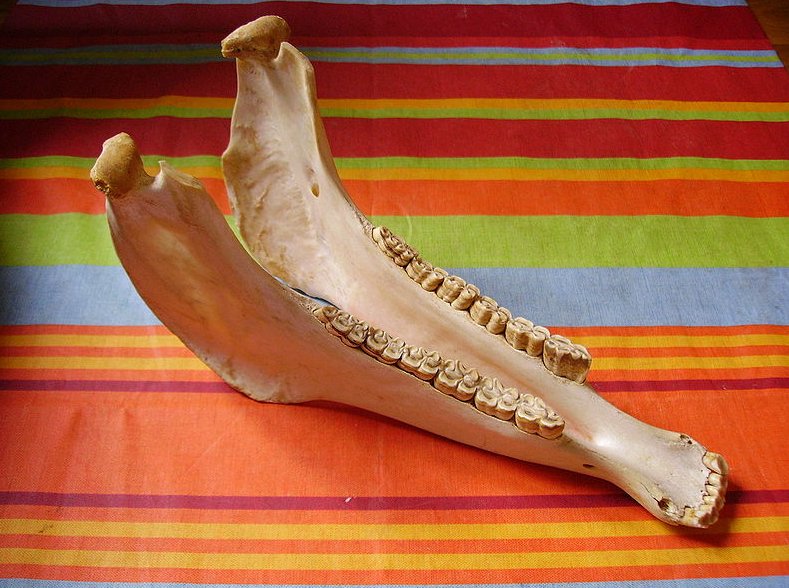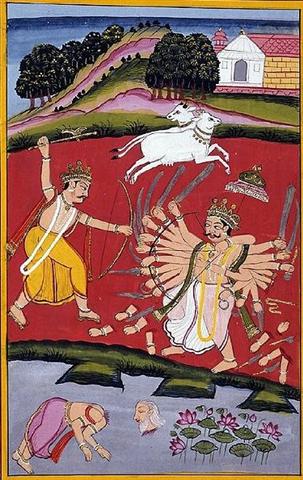6. In other words, I suggest there was a crisis when it was discovered that the age of Pisces was looming far ahead. It would end our world of the living in a great flood.
In order to be able to sleep soundly in the night and stop worrying for the future generations the sacred jawbone came as a blessing.
 It should be noted that the Mayan number heads had what evidently are old jawbones as signs for numbers from 10:  Number 11 is an exception, and we know why - because its meaning is 'one more' (than 10), i.e. a number implying 'birth'. It would be wrong to put a dead old bone there. 12 is also an exception, though I have no explanation. Perhaps there was a wish to have 8 jawbones, a sign of Moon. There are 20 dots distributed on the bones:
The jawbone enables Sun to move through the water, 'like a knife through butter': "The Hindu scriptures mention that there is an Equine-head of vast proportions which roves through the seas. Blazing fires constantly issue from its mouth and these drink up the sea-water. It always makes a roaring noise. It is called Vadava-mukha. The fire issuing from it is called Vadava-nala. The waters of the Ocean are like clarified butter. The Equine-head drinks them up as the sacrificial fire drinks the libations of clarified butter poured upon it. The origin of the Vadava fire is sometimes ascribed to the wrath of Urva, a Rishi of the race of Jamadagni. Hence it is sometimes called Aurvya-fire." (Hamlet's Mill) The family of Jamadagni could be potentially useful for us. The following is from Wikipedia: "Jamadagni (or Jamdagni) is one of the Saptarishis (Seven Great Sages, Rishi) in the seventh, i.e. the present Manvantara. He was a descendant of the sage Bhrigu, one of the Prajapatis created by Brahma, the God of Creation. Jamadagni has five children with his wife Renuka, the youngest of whom was Parashurama, an avatar of Lord Vishnu. Renuka was a very devoted wife and the power of her chastity was manifest. Such was this power, that she used to fetch water from the river in a pot made of unbaked clay every day. The pot would hold together because of her devotion to her husband. One day, when she was at the river, a group of people - Gandharvas - happened to be passing by in the sky, in the chariot. Smitten with desire for their luxuries, for merely an instant, the damage to her powers was done. The unbaked pot that she was carrying, dissolved into the river. She was no longer chaste of mind. Afraid to go back to her husband, she waited at the river bank. Meanwhile Jamadagni, who was waiting for fresh water to begin his morning sacrifices, noticed that his wife had not yet returned from the river. By his yogic powers, he divined all that had taken place. Exceedingly angry with his wife, he called his eldest son, told him what had happened and asked him to execute his mother. Horror-stricken, his son refused to perform this deed. He then asked all of his sons, in the order of their seniority, to execute their mother. While all the elder sons refused (Jamadagni turned them to stone), only his youngest son, Parashurama, ever-obedient and righteous, at once beheaded his mother with his axe. Jamadagni, pleased, offered to grant two boons to Parashurama, who at once asked that his mother be restored to life and his brothers to be unturned from stone and accepted into the family again. Impressed by his son's devotion and affection for Jamadagni, he granted this boon and many others. Jamadagni was later killed by a Kshatriya king Kartavirya Arjuna, over a dispute over a divine calf named Kamadhenu.
Parashurama killing Kartavirya Arjuna, while the decapitated body of Jamadagni lies in the foreground, in the water. On land there are 8 cutoff hands. |
|||||||||||||||||||||||||||||||||
